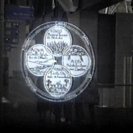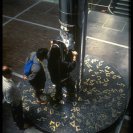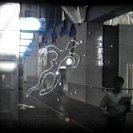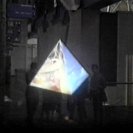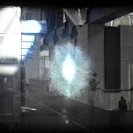In this work a chrome-plated column stands on a round black terrazzo base inlaid with brass signs representing a Hebraic astrological map. This column has a viewing aperture, two controlling handles, and a pair of loudspeakers. Looking through the opening in the column, the spectator sees a large virtual image projected into the museum space - this image is overlaid on his view of the real environment. By pushing the handles, the spectator can interactively control the rotation of the column and the movement of this virtual image. Sound and image are interactively accessed from two videodisc players and the virtual image is generated by an optical display system within the column.
Initially there is a 360-degree panorama representing six different symbolic sites in a landscape. As the spectator rotates the column, he moves his point of view in a panorama apparently floating all around him. The viewer can select one of the six sites by pressing a button on the column handle. Linked to each site is an approximately three-minute video sequence which articulates the specific themes embodied by that place. At the end of each video sequence, the viewer returned to the panorama and then, by turning the column, choose another place to go to.
The title of this work Inventer La Terre/Inventing the World refers to its central theme - the exemplification of archaic, mythological and esoteric world sciences. The six symbolic panoramic sites and their respective video sequences are each concerned with specific aspects of this overall subject - the totemic world, primal creation myths, astrology and astronomy, sacred geometry, hermetic geography, and the creation of fictional worlds in art and literature. 3D image synthesis, digital image processing and digital post production techniques were used extensively in these visual sequences.
Credits:
Sound: Walter Maioli








